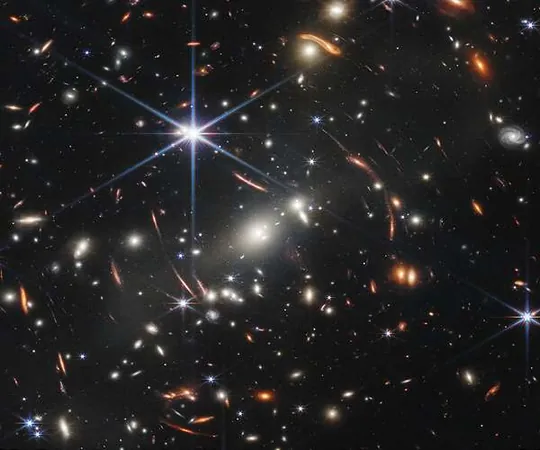
Discover the Stunning Secrets of the Universe's Most Ancient Galaxy—13.4 Billion Years Old!
2025-01-13
Author: Mei
A groundbreaking discovery has emerged from an international team of astronomers, spearheaded by the National Astronomical Observatory of Japan. They have successfully identified emissions from various atomic transitions in the primordial galaxy known as GHZ2 (GLASS-z12), which existed an astonishing 13.4 billion years ago. This revelation sheds light on the universe's earliest structures and challenges our understanding of how galaxies formed.
Using the powerful combination of over forty antennas from the Atacama Large Millimeter/submillimeter Array (ALMA) and the state-of-the-art James Webb Space Telescope (JWST), researchers tuned in to a seemingly empty patch of sky for hours. What they found was extraordinary: emissions from excited atoms of hydrogen and oxygen, marking the first such detection in galaxies located more than 13 billion light-years from Earth.
The discoveries trace back to JWST's first observations of extragalactic objects in 2022, where GHZ2 emerged as one of the brightest and most distant galaxy candidates. This landmark study is crucial in advancing theories of galaxy formation and evolution, providing a deeper comprehension of cosmic history at a time when the universe was only about 400 million years old—just 3% of its current age.
In their observations, ALMA successfully detected the [OIII] 88um transition from doubly ionized oxygen in GHZ2, pinpointing it at a redshift of z=12.333. This data is revolutionary, as it represents the most distant detection of multiple emission lines ever recorded. When combined with additional readings from the JWST’s NIRSpec and MIRI instruments, researchers can now accurately characterize this ancient galaxy, unlocking secrets about its composition and behavior.
What's even more fascinating is that GHZ2 exhibits extreme star formation activity influenced by its unique conditions in the early universe. The metallicity of this galaxy—essentially the level of heavier elements compared to hydrogen—is strikingly lower than in many previously studied galaxies, registering at about one-tenth the solar level. Despite its youth, GHZ2 is populated by a young cohort of massive and hot stars that contribute to its exceptional brightness.
The mass of GHZ2 is estimated to be several hundred million times that of our Sun, all concentrated in a remarkably compact area of under 100 parsecs. Such density rivals that of globular clusters—tight-knit groups of aged stars found within the Milky Way. The comparison hints at potential links between GHZ2 and the origins of these enigmatic clusters, a question that has perplexed astronomers for decades.
Tom Bakx, a researcher at Chalmers University in Sweden, emphasized the significance of this study as a major stride toward unraveling the complex history of galaxies in the early universe. The synergy between ALMA and JWST showcases their exceptional capabilities in pushing the boundaries of astronomical research.
This monumental breakthrough not only enhances our knowledge of galaxy formation but also sets the stage for future explorations into the cosmos's infancy. Don't miss out on the ongoing journey to decipher the universe's greatest mysteries as we continue to unveil the facts about galaxies from billions of years ago!


 Brasil (PT)
Brasil (PT)
 Canada (EN)
Canada (EN)
 Chile (ES)
Chile (ES)
 Česko (CS)
Česko (CS)
 대한민국 (KO)
대한민국 (KO)
 España (ES)
España (ES)
 France (FR)
France (FR)
 Hong Kong (EN)
Hong Kong (EN)
 Italia (IT)
Italia (IT)
 日本 (JA)
日本 (JA)
 Magyarország (HU)
Magyarország (HU)
 Norge (NO)
Norge (NO)
 Polska (PL)
Polska (PL)
 Schweiz (DE)
Schweiz (DE)
 Singapore (EN)
Singapore (EN)
 Sverige (SV)
Sverige (SV)
 Suomi (FI)
Suomi (FI)
 Türkiye (TR)
Türkiye (TR)
 الإمارات العربية المتحدة (AR)
الإمارات العربية المتحدة (AR)